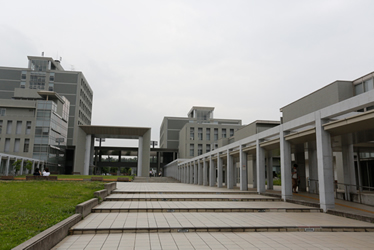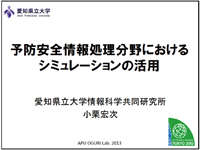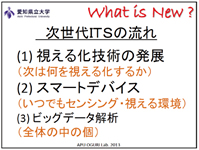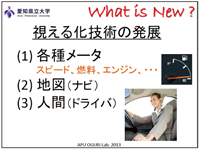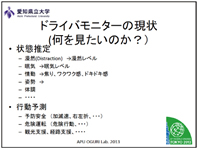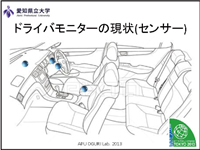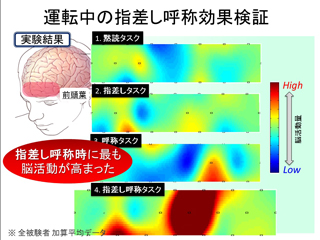Academy User Vol.5
Aichi Prefectural University
Oguri Lab, School of Information Science and Technology
Accumulated Knowledge About Biosignal Treatment, Developing Estimation Technology of a Driver's States:
Applying UC-win/Road to Self-made Simulator, Relentless Pursuit of Reality
Academy Information
Oguri Lab, School of Information Science and Technology, Aichi Prefectural UniversityURL : http://www.ist.aichi-pu.ac.jp/
Location: Nagakute City, Aichi Prefecture
Research contents: biological signal analysis, estimation of a driver's states
Starting from the center of Nagoya city on the Nagoya Municipal Subway and changing to the Aichi Rapid Transit Tobu Kyuryo Line (Linimo), it takes a little longer than 40 min. to Ai Chikyuuhakukinen Park Station where linear motor cars arrive and depart. In the forest extending northward lies the Nagakute Campus of Aichi Prefectural University, integrated with nature. In the building located at the deepest part of the school buildings stretching in a row in the campus, Professor Koji Oguri at School of Information Science and Technology, Aichi Prefectural University has his laboratory and seminar room. While improving the self-made driving simulators, various biological data are obtained with them. Those data help advance technology to estimate the driver's states, leading to realization of a secure, safe, and comfortable mobility society of the next generation. This is how Professor Koji Oguri describes part of his research issues. In his Lab "UC-win/Road", a 3D real-time VR product of FORUM8 is adopted through the approach to developing simulators with more reality. It has just been updated to the latest version lately.
Searching for New Contribution to Communities, Supporting Manufacturing in Terms of ICT

Aichi Prefectural University
The origin of Aichi Prefectural University can be traced back to Aichi Prefectural Women’s Special College founded in 1947. Then through repeated reorganization and expansion, it was reorganized as coeducational Aichi Prefectural University in 1966. In 1988, partly because the former main campus in Nagoya city became too small, the Univ. moved to a corner of the east hill of Nagakute town (currently Nagakute city), Aichi prefecture, adjacent to the northeast of Nagoya city.
On the other hand, along with the holding of the 2005 World Exposition in Aichi, Japan (Exposition of Global Harmony), Aichi prefecture placed the east hill of Nagoya including Aichiseishounen Park that had been the main venue of the Expo (renamed as “Ai Chikyuuhakukinen Park (Memorial Park for Expo of Global Harmony)”) as "Aichi Academic Research and Development Zone". Making most of the location of research and training organizations, they decided to aim at forming a brain base. Relocation of the Univ. is also linked with this vision. In the neighborhood established "Knowledge Hub Aichi", which the Prefecture is developing in order to support manufacturing work with high added value.
With this as its background, the Univ. founded the School of Information Science and Technology as its first scientific school in moving to the new campus. A central point for global manufacturing industries, Aichi Pref. is home for not a few universities and colleges specializing in the related fields. Because of this, the Univ. aimed to reinforce the field to connect these technologies to information science, as Prof. Oguri explains.
The Univ. has two campuses at Nagakute and Moriyama. In the former, Schools of Foreign Studies, Japanese Studies, Education and Welfare, and Information Science and Technology are located. In the latter, School of Nursing and Health is located. Graduate Schools of International Studies, Human Development, Nursing & Health, and Information Science and Technology are also established.
Among these, students of School of Information Science and Technology learn information basic technology in two years after entrance. When going into the 3rd grade, they are divided into 3 courses: information systems, media robotics, and simulation science, with curriculums arranged for improving specialty. In particular, they obtain good results in RoboCup (Robot Soccer World Cup played by autonomous movable robots with the aim to unite and promote robotics and AI research) annually. In addition, it can be said that their studies focusing on ITS (intelligent transportation systems) represent the unique aspect of the School.
Prof. Oguri also serves as the Director of Institute of Information Science and Technology attached to the Univ. In parallel with education for students, the Institute performs research activities to contribute to the improvement in competitiveness of the prosperous manufacturing communities in terms of utilization of information and communication technologies (ICT).
From Biosignal Analysis to Estimation of Driver's States Based on It
Prof. Oguri originally specializes in biosignal processing. Accordingly, when he was working in Nagoya Institute of Technology, he collaborated with some medical schools of other universities in the region. He had some data such as electrocardiograms, electroencephalograms, and blood tests etc., or other biomedical signals provided for him. Through analyzing these data and extraction of significant information (data mining), he performed, for example, early detection of diseases as well as estimation of types of medicines effective against individual diseases. He further made efforts in simulating the issue of forward and reverse directions of electrocardiograms using advancing computer technology.
When he moved to Aichi Prefectural University in 1998, he was requested to conduct "studies that would contribute to local industries or solutions for local challenges". Thus he explored new study themes different from ones in the past. Then taking a hint from a person related to the automobile industry that "the technology for estimating disease states from the biosignals of the patients in hospitals might be useful in detecting catnaps from biosignal analysis of the drivers", he made an attempt and paid attention to its potential. Moreover, as "the 11th ITS World Congress on ITS Nagoya, Aichi 2004, Japan" and "Exposition of Global Harmony (Expo 2005 Aichi Japan)" were coming soon, he had come to promote studies targeting ITS in aiming at these events.
Since then, using drive simulators, he has been studying on medical estimation of the driver’s states by obtaining not only vehicle information but also biosignals from test subjects. That is, this study searches for relationship between the driver's states and driving by connecting information obtained directly from humans with their behavior in driving a car, for example, "In what condition is the driver driving?", "What if he is sleepy?", or "In what situation does the driver cause an accident?" through measurement of the cerebral blood flow while driving or analysis of face images. Currently studies on biomedical engineering accounts for 30-40%, while studies on ITS (preventive safety technology) have come to account for more than half, as he says.
One of the interesting studies in the Lab in recent years is "finger-pointing verbal check". Focusing on "finger-pointing verbal check" performed at the railways etc., Prof. Oguri measured how the driver's brain changed when the "finger-pointing verbal check" was done. According to his explanation, he measured the brain activity of a driver while he or she was driving a driving simulator using a near-infrared spectroscopy system (NIRS). Then it was indicated that conducting the "finger-pointing verbal check" made the brain very active and that it was effective in preventing oversight phenomena.
"Aichi Prefecture has been keeping the worst 1 for number of traffic
fatalities. Therefore, we would like to develop a new safety technology
through studies (of our own), and contribute to reduction of traffic accidents
as much as possible."
Driving a Car and Physical Condition Management
In the modern society, driving a car composes part of life, says Prof. Oguri.
On the other hand, since it is possible to acquire lifelog in many different ways today, he focused on approaches such as "trying not to be ill as much as possible by checking the daily changes in physical condition", rather than "going to hospital because I have become ill". This has led to his viewpoint, "the condition of the driver while driving a car must be an excellent barometer in measuring his or her physical condition".
In other words, in order to extend healthy life expectancy so that people can continue to live actively, it is wasteful if one is only driving a car. Estimating the driver's states based on the data obtained while driving allows the car to function like a "Moving clinic". What's more, the results can be led to prevention of accidents at the same time. As a result, traffic jams can be avoided and stresses can be reduced; this is what he draws as an image of a cycle which he thinks is ideal.
Applying UC-win/Road to the Process of Manufacturing DS on His Own
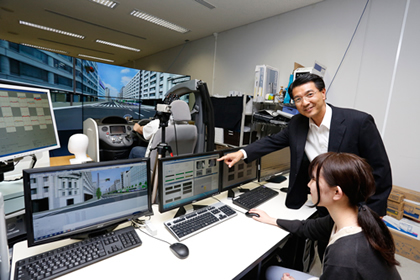
"There is no way to make something devoid of other than creating on our own"
Since he started studies related to automobiles under such circumstances as described above, partly because he had no special equipment, Prof. Oguri and others had been making simulators basically on their own. They performed programming with computers to create simulators. Regarding hardware, they built up parts of automobiles they had purchased from outside and connected a game controller to manufacture a driving simulator (DS), to conduct from acquisition to analysis of biosignals.
They kept on studying while improving self-made simulators for 2 to 3 years, when Prof. Oguri came across UC-win/Road of FORUM8. He purchased it right away because "it had a function of editing courses, making it possible to create courses that we wanted to rather easily. It was visually good and excellent in operability, better-made than what I had been making for about three years." Feeling vexed at the beginning, he thought "I will be sure to make better one". However, while coping with his original studies that vary widely he could not spend time only on creating simulators. So he is doing his best to develop DS with higher reality utilizing UC-win/Road since then.
Currently the Lab is using 4 types of DS in parallel. One of the systems has been upgraded repeatedly, equipped with the simulator (program) created using UC-win/Road that is the 3rd generation for them, and manufactured by themselves. This is one of the main DS they are using. The latest version of UC-win/Road, which is the 4th generation for the Lab, has just been introduced in the Lab.
Technology to Estimate States in the Future and Expectation Towards DS
Most of traffic accidents are caused by human errors, and he wants to develop technologies to reduce them as much as possible. On the other hand, it has come to be found that driving cars cause emotional uplift for the drivers like getting exited or cheerful, making their brains active. Thus by using this, it is expected to have effect in maintaining activities of elderly people and extending healthy life expectancy. Nevertheless, there is a tendency to control driving by elderly people since a problem of accidents caused by elderly drivers having dementia is pointed out recently in particular. Thus, Prof. Oguri mentions the direction to go in the future, that he would like to develop technologies to estimate states that lead to determination of danger and effects that accompany driving.
In addition, as automated driving becomes advanced, it will be important to evaluate the shift between automated driving and the driver’s manual driving, or human behavior happening there.
To support these points, Prof. Oguri mentions three elements required for the future DS as follows: 1) Motion Reality, capable of moving in a similar way to the actual one. 2) Vision reality, which allows immersion feeling to increase using high resolution. 3) Emotion Reality, creating the similar situation to the actual one. Among them, Motion Reality and Vision Reality have been somewhat improved in accuracy, but Emotion has as yet been "scarcely dealt with".
For example, in trying to create situations of near-miss events using the current DS, in many cases they are so made to let a bicycle or pedestrian rushing out forcibly. In this case it is obliged to represent the situation with a determined position and timing using a scenario. In this case, some drivers may have clear consciousness and others may be careless. It is impossible to simulate danger situations with desired timing. However in reality, accidents are likely to happen when a driver is in an unstable condition. The behavior in such conditions is exactly what he wants to simulate with DS. The studies conducted so far in the Oguri Lab have enabled them to grasp the timing when the driver's states becomes unstable like this from biosignals. The challenge is that though he wants to reflect them in DS, it is not easy to realize, as Prof. Oguri points out. He expects that if this challenge is cleared, more detailed analysis of accident scenes and development of safety equipment will be realized.

